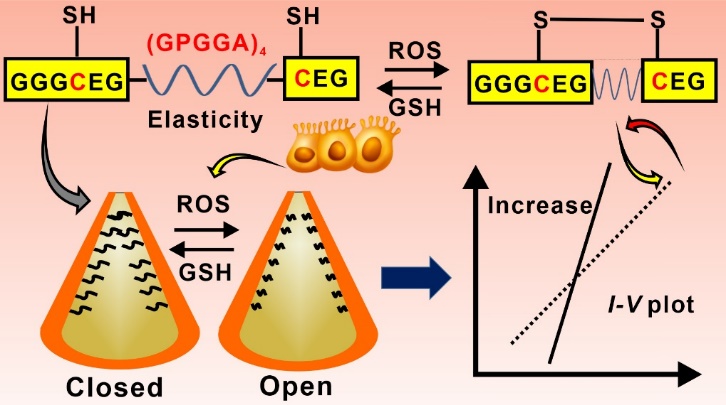Recently, a paper titled "Accurate detection of reactive oxygen species by tuning an elastic motif (GPGGA)4 in nanopores" by Professor Liu Bo from the School of Biomedical Engineering, the Faculty of Medicine, Dalian University of Technology was published in the journal Chemical Communications (DOI:10.1039/D3CC00563A).

Reactive oxygen species (ROS) are among the most crucial molecules in many complex biological processes. Abnormal generation of ROS has been proven to be associated with neurodegenerative diseases, diabetes, cancer cell migration, and various other pathologies. Therefore, the development of sensitive and specific ROS detection tools is of vital importance for a better understanding of the progression of these diseases. Fluorescent probes offer the greatest opportunity to meet this need, usually relying on fluorescent turn-on or ratio signals. However, fluorescent probes still have several demerits to be dealt with, such as low excitation and emission efficiency, poor uniform distribution, and significant cellular toxicity. Hence, developing a ROS-sensitive sensor to overcome these shortcomings remains a significant challenge.
Inspired by the elasticity of spider silk proteins, this study designed a ROS-responsive peptide GGGCEG(GPGGA)4CEG (hereafter referred to as Elastic Peptide ES Peptide). When this peptide is modified onto conical nanopores, it forms a blocking current. Because the (GPGGA)4 in the ES peptide has two cysteines on either side that can be oxidized to form intramolecular disulfide bonds (-S-S-), it causes structural changes in the ES peptide. This, in turn, results in changes in the nanopore diameter and eventually leads to variations in the nanopore current, thereby achieving precise ROS detection. This research offers a novel approach for the development of ROS sensors and also opens up new directions for disease molecule detection.

The journal Chemical Communications is a flagship publication of the Royal Society of Chemistry (RSC) and was founded in 1996. Covering the entire field of chemical sciences, it is recognized as a high-level publication in the field of chemistry and is included in the Nature Index. Wang Cunli, a Ph.D. student (enrolling in 2020) from the School of Biomedical Engineering, is the first author of this paper. Professor Liu Bo from the School of Biomedical Engineering is the corresponding author, with Dalian University of Technology's School of Biomedical Engineering being the primary institution credited for this paper. This work was supported by the National Natural Science Foundation's project (NSFC No. 32071252).
Article link:https://pubs.rsc.org/en/content/articlelanding/2023/cc/d3cc00563a

